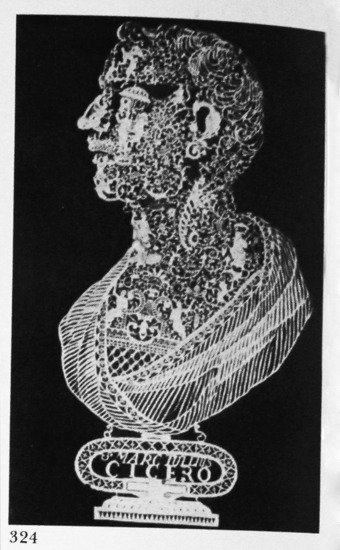Chearkly, Anton (McKechnie Section 1)
Recorded by Jackson (Dictionary) as an artist who produced what appears to have been a fine example of early paper cutting. This was a bust of Cicero, but Jackson gives no information about the whereabouts of the piece at the time she was writing. It was composed of mixed cut and painted work, and bore a date of 1744. The only illustration of the piece known to me is a photograph in my possession, formerly owned by Jackson.
It seems possible that this artist was, in fact, Antony Chearnley, an early Irish landscape artist now known to have been working at about this date. Until two years ago, only engravings of his work were known. Recently, however, a large painting of Lismore was identified as being from his hand, on the evidence of an engraving after this original in Charles Smith's History of County Waterford (1746). Another painting, a view of Kinsale, painted in c. 1750 and engraved in Volume One of Smith's Ancient and Present State of Cork, has also been identified as his work. (See Anne Crooshank, 'Early Landscape Painters in Ireland', Country Life, 24 August 1972.)
Chearnley's style was apparently based on that of a Dutch artist, Johann van der Hagen, who in c. 1725 initiated in Ireland the art of painting both decorative murals and landscapes, and achieved considerable fame as the first really able professional artist who lived in Ireland by painting landscapes there.
Some of the engravings are recorded as being signed 'Antho. Chearnley, Gent., Burnt Court, delin.' This signature seems to have been intended to make it clear that Chearnley was a man of some standing, which indeed he appears to have been, since he built himself a fine residence near the ruins of the early seventeenth-century castle of Burnt Court. This residence was illustrated in one of the artist's views in Grose's Antiquities of Ireland (1791). Grose says (Volume Two, page 58) that Chearnley 'deserves to be remembered for cultivating the art of design when few pursued it, in 1740, in Ireland . . . He had a large collection of views from ancient remains, which probably lie in private hands . . . ' The coincidence of dates, as well as the phrase 'for cultivating the art of design', does suggest that the piece described by Jackson may indeed have been by this artist, but one clearly cannot be sure. The whole bust measured only 6½ x 3½ in., and the signature on the pedestal would therefore have been small and difficult to read.
With regard to Chearkly's work, here we are concerned only with the bust of Cicero. As far as one can judge from Jackson's description and from the surviving photograph, it seems to have been built up in a design of mixed floral forms and arabesques, in which were mingled human heads, birds and cornucopiae, with minute figures painted en grisaille. The piece bears interesting comparison with the work of another early silhouette artist, Nathaniel Bermingham (q.v.).
Jackson interpreted the signature on the pedestal of the bust of Cicero as 'Anton Chearkly, 1744'. A signature of Chearnley has already been given above.
Ill. 324

Marcus Tullius Cicero
Silhouette, cut from white paper and painted
1744
6½ x 3½in./165 x 90mm.
Signed on the pedestal, ‘Anton Chearkly, 1744’.
From a photograph in the author’s possession
